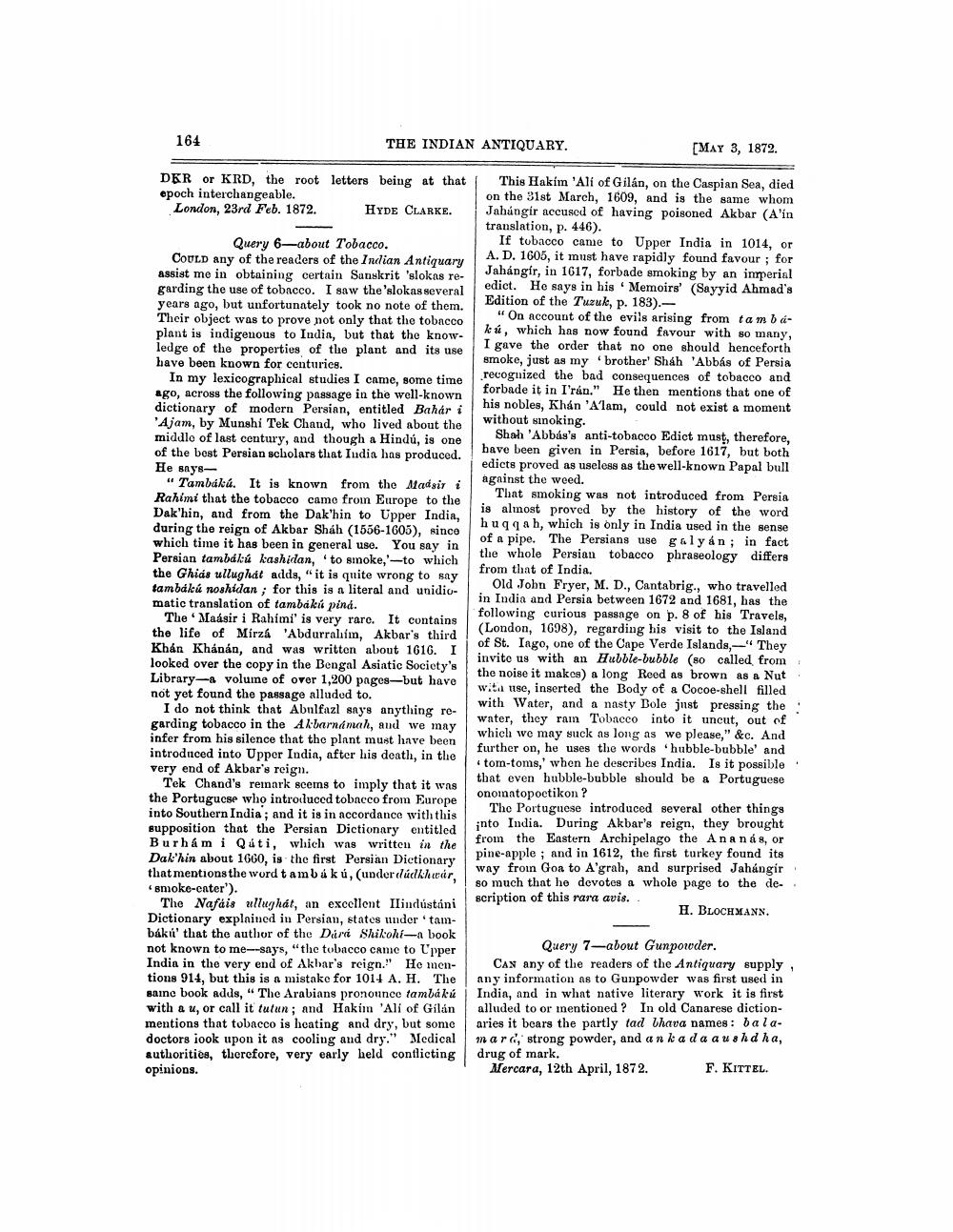________________
164
THE INDIAN ANTIQUARY.
DKR or KRD, the root letters being at that epoch interchangeable.
London, 23rd Feb. 1872.
HYDE CLARKE.
Query 6-about Tobacco.
COULD any of the readers of the Indian Antiquary assist me in obtaining certain Sanskrit 'slokas regarding the use of tobacco. I saw the 'slokas several years ago, but unfortunately took no note of them. Their object was to prove not only that the tobacco plant is indigenous to India, but that the knowledge of the properties of the plant and its use have been known for centuries.
In my lexicographical studies I came, some time ago, across the following passage in the well-known dictionary of modern Persian, entitled Bahár i 'Ajam, by Munshi Tek Chand, who lived about the middle of last century, and though a Hindú, is one of the best Persian scholars that India has produced. He says
"Tambákú. It is known from the Madsir i Rahimi that the tobacco came from Europe to the Dak'hin, and from the Dak'hin to Upper India, during the reign of Akbar Sháh (1556-1605), since which time it has been in general use. You say in Persian tambákú kashidan, 'to smoke,'-to which the Ghias ullughát adds, "it is quite wrong to say tambákú noshidan; for this is a literal and unidiomatic translation of tambákú piná.
The Maásir i Rahimi' is very rare. It contains the life of Mírzá 'Abdurrahim, Akbar's third Khán Khánán, and was written about 1616. I looked over the copy in the Bengal Asiatic Society's Library-a volume of over 1,200 pages-but have not yet found the passage alluded to.
I do not think that Abulfazl says anything regarding tobacco in the Akbarnámah, and we may infer from his silence that the plant must have been introduced into Upper India, after his death, in the very end of Akbar's reign.
Tek Chand's remark seems to imply that it was the Portuguese who introduced tobacco from Europe into Southern India; and it is in accordance with this supposition that the Persian Dictionary entitled Burhám i Qúti, which was written in the Dak'hin about 1660, is the first Persian Dictionary that mentions the word t amb á kú, (under dúdkhwar, 'smoke-cater').
The Nafáis ullughát, an excellent Ilindústáni Dictionary explained in Persian, states under 'tambákú' that the author of the Dará Shikohi-a book not known to me--says, "the tobacco came to Upper India in the very end of Akbar's reign." He mentions 914, but this is a mistake for 1014 A. H. The same book adds, "The Arabians pronounce tambȧkú with a u, or call it tutun; and Hakim 'Ali of Gilán mentions that tobacco is heating and dry, but some doctors look upon it as cooling and dry." Medical authorities, therefore, very early held conflicting opinions.
[MAY 3, 1872.
This Hakim 'Ali of Gilán, on the Caspian Sea, died on the 31st March, 1609, and is the same whom Jahangir accused of having poisoned Akbar (A'in translation, p. 446).
If tobacco came to Upper India in 1014, or A. D. 1605, it must have rapidly found favour; for Jahangir, in 1617, forbade smoking by an imperial edict. He says in his Memoirs' (Sayyid Ahmad's Edition of the Tuzuk, p. 183).
"On account of the evils arising from tam bákú, which has now found favour with so many, I gave the order that no one should henceforth smoke, just as my brother' Sháh 'Abbás of Persia recognized the bad consequences of tobacco and forbade it in I'rán." He then mentions that one of his nobles, Khán 'A'lam, could not exist a moment without smoking.
Shah 'Abbas's anti-tobacco Edict must, therefore, have been given in Persia, before 1617, but both edicts proved as useless as the well-known Papal bull against the weed.
That smoking was not introduced from Persia is almost proved by the history of the word huqqah, which is only in India used in the sense of a pipe. The Persians use galyán; in fact the whole Persian tobacco phraseology differs from that of India.
Old John Fryer, M. D., Cantabrig., who travelled in India and Persia between 1672 and 1681, has the following curious passage on p. 8 of his Travels, (London, 1698), regarding his visit to the Island of St. Iago, one of the Cape Verde Islands,-" They invite us with an Hubble-bubble (so called from the noise it makes) a long Reed as brown as a Nut with use, inserted the Body of a Cocoe-shell filled with Water, and a nasty Bole just pressing the water, they ram Tobacco into it uncut, out of which we may suck as long as we please," &c. And further on, he uses the words 'hubble-bubble' and tom-toms,' when he describes India. Is it possible that even hubble-bubble should be a Portuguese onomatopoetikon?
The Portuguese introduced several other things into India. During Akbar's reign, they brought from the Eastern Archipelago the Ananás, or pine-apple; and in 1612, the first turkey found its way from Goa to A'grah, and surprised Jahangir so much that he devotes a whole page to the description of this rara avis.
H. BLOCHMANN.
Query 7-about Gunpowder.
CAN any of the readers of the Antiquary supply, any information as to Gunpowder was first used in India, and in what native literary work it is first alluded to or mentioned? In old Canarese dictionaries it bears the partly tad bhava names: balamard, strong powder, and an kada aushdha, drug of mark.
Mercara, 12th April, 1872.
F. KITTEL.




